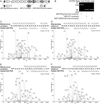Myosin binding protein-C slow is a novel substrate for protein kinase A (PKA) and C (PKC) in skeletal muscle
- PMID: 21888435
- PMCID: PMC3209537
- DOI: 10.1021/pr200355w
Myosin binding protein-C slow is a novel substrate for protein kinase A (PKA) and C (PKC) in skeletal muscle
Abstract
Myosin Binding Protein-C slow (MyBP-C slow), a family of thick filament-associated proteins, consists of four alternatively spliced forms, namely variants 1-4. Variants 1-4 share common structures and sequences; however, they differ in three regions: variants 1 and 2 contain a novel 25-residue long insertion at the extreme NH(2)-terminus, variant 3 carries an 18-amino acid long segment within immunoglobulin (Ig) domain C7, and variant 1 contains a unique COOH-terminus consisting of 26-amino acids, while variant 4 does not possess any of these insertions. Variants 1-4 are expressed in variable amounts among skeletal muscles, exhibiting different topographies and potentially distinct functions. To date, the regulatory mechanisms that modulate the activities of MyBP-C slow are unknown. Using an array of proteomic approaches, we show that MyBP-C slow comprises a family of phosphoproteins. Ser-59 and Ser-62 are substrates for PKA, while Ser-83 and Thr-84 are substrates for PKC. Moreover, Ser-204 is a substrate for both PKA and PKC. Importantly, the levels of phosphorylated skeletal MyBP-C proteins (i.e., slow and fast) are notably increased in mouse dystrophic muscles, even though their overall amounts are significantly decreased. In brief, our studies are the first to show that the MyBP-C slow subfamily undergoes phosphorylation, which may regulate its activities in normalcy and disease.
Figures




References
-
- Oakley CE, Chamoun J, Brown LJ, Hambly BD. Myosin binding protein-C: enigmatic regulator of cardiac contraction. Int J Biochem Cell Biol. 2007;39(12):2161–2166. - PubMed
-
- Gautel M, Castiglione Morelli MA, Pfuhl M, Motta A, Pastore A. A calmodulin-binding sequence in the C-terminus of human cardiac titin kinase. Eur J Biochem. 1995;230(2):752–759. - PubMed
-
- Weber FE, Vaughan KT, Reinach FC, Fischman DA. Complete sequence of human fast-type and slow-type muscle myosin-binding-protein C (MyBP-C). Differential expression, conserved domain structure and chromosome assignment. Eur J Biochem. 1993;216(2):661–669. - PubMed
Publication types
MeSH terms
Substances
Grants and funding
LinkOut - more resources
Full Text Sources
Miscellaneous

